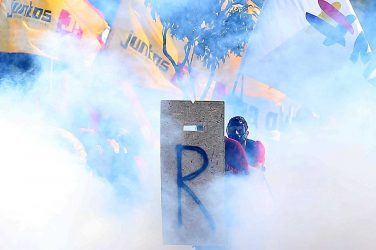 Washington’s regime change machinery has for the time being succeeded in removing an important link in the alliance of large emerging nations by railroading through a Senate impeachment of the duly elected President, Dilma Rousseff.
Washington’s regime change machinery has for the time being succeeded in removing an important link in the alliance of large emerging nations by railroading through a Senate impeachment of the duly elected President, Dilma Rousseff.
On August 31 her Vice President Michel Temer was sworn in as President. In his first speech as president, the cynical Temer called for a government of “national salvation,” asking for the trust of the Brazilian people.
He indicated plans to reform, and has also signaled his intention to overhaul the pension system and labor laws, and cut public spending, all themes beloved of Wall Street banks, of the International Monetary Fund and their Washington Consensus.
Now after less than three weeks at the job, Temer has unveiled plans for wholesale privatization of Brazil’s crown jewels, starting with oil. The planned Wall Street rape of Brazil is about to begin.

It’s important to keep in mind that elected President Rousseff was not convicted or even formally charged with any concrete act of corruption, even though the pro-oligarchy mainstream Brazil media, led by O Globo ran a media defamation campaign creating the basis to railroad Rousseff into formal impeachment before the Senate.
The shift took place after the opposition PMDB party of Temer, on March 29, broke their coalition with Rousseff’s Workers’ Party, as accusations of Petrobras-linked corruption were made against Rousseff and former president Luiz Inácio Lula da Silva.
On August 31, 61 Senators voted to remove her while 20 voted against removal. The formal charge was “manipulation of the state budget” before the 2014 elections to hide the size of the deficit. She vehemently denies the charge.
Indeed, the Senate issued its own expert report that concluded there was “no indication of direct or indirect action by Dilma” in any illegal budgetary maneuvers.
According to the Associated Press, “Independent auditors hired by Brazil’s Senate said in a report released Monday that suspended President Dilma Rousseff didn’t engage in the creative accounting she was charged with at her impeachment trial.” Under an honest system that would have ended the impeachment then and there. Not in Brazil.
In effect, she was impeached for the dramatic decline in the Brazilian economy, a decline deliberately pushed along as US credit rating agencies downgraded Brazilian debt, and international and mainstream Brazilian media kept the Petrobras corruption allegations in the spotlight.
Importantly, the Senate did not ban her from office for 8 years as Washington had hoped, and she has promised an electoral return. The Washington-steered Temer has until end of 2018 to deliver Brazil to Temer’s foreign masters before his term legally ends.
Notably, Temer himself was accused of corruption in the Petrobras state oil company investigations. He reportedly asked the then-head of the transportation unit of Petróleo Brasileiro SA in 2012 to arrange illegal campaign contributions to Temer’s party which was running a Washington-backed campaign to oust Rousseff’s Workers’ Party.
Then this June, only days into his serving as acting president, two of Temer’s own chosen ministers, including the Minister of Transparency, were forced to resign in response to allegations that they sought to subvert the probe into massive graft at Petrobras.
One of the two, Temer’s extremely close ally Romero Jucá, was caught on tape plotting Dilma’s impeachment as a way to shut down the ongoing Petrobras corruption investigation, as well as indicating that Brazil’s military, the media, and the courts were all participants in the impeachment plotting.
In brief, the removal of Dilma Rousseff and her Workers’ Party after 13 years in Brazil’s leadership was a new form of Color Revolution from Washington, one we might call a judicial coup by corrupt judges and congressmen. Of the 594 members of the Congress, as the Toronto Globe and Mail reported, “318 are under investigation or face charges” while their target, President Rousseff, “herself faces no allegation of financial impropriety.”
The day after the first Lower House impeachment vote in April, a leading member of Temer’s PSDP party, Senator Aloysio Nunes, went to Washington, in a mission organized by former Bill Clinton Secretary of State Madeline Albright’s lobbying firm, Albright Stonebridge Group. Nunes, as president of the Brazilian Senate’s Foreign Relations Committee, has repeatedly advocated that Brazil once again move closer to an alliance with the US and UK.
Madeline Albright, a Director of the leading US think-tank, Council on Foreign Relations, is also chair of the prime US Government “Color Revolution” NGO, the National Democratic Institute (NDI). Nothing fishy here, or? Nunes reportedly went to Washington to rally backing for Temer and the unfolding judicial coup against Rousseff.
A key player from the side of Washington, Rousseff’s de facto political executioner, was, once again, Vice President Joe Biden, the “Dick Cheney” dirty operator-in-chief in the Obama Administration.
Biden’s Fateful Brazil Trip
In May, 2013, US Vice President Joe Biden made a fateful visit to Brazil to meet with President Rousseff. In January 2011 Rousseff had succeeded her Workers’ Party mentor, Luis Inácio Lula da Silva, or Lula, who constitutionally was limited to two consecutive terms.
Biden went to Brazil to discuss oil with the new President. Relations between Lula and Washington had chilled as Lula backed Iran against US sanctions and came economically closer to China.
In late 2007 Petrobras had discovered what was estimated to be a mammoth new basin of high-quality oil on the Brazilian Continental Shelf offshore in the Santos Basin. In total the Brazil Continental Shelf could contain over 100 billion barrels of oil, transforming the country into a major world oil and gas power, something Exxon and Chevron, the US oil giants wanted to control.
In 2009, according to leaked US diplomatic cables published by Wikileaks, the US Consulate in Rio wrote that Exxon and Chevron were trying in vain to alter a law advanced by Rousseff’s mentor and predecessor in her Brazilian Workers’ Party, President Luis Inácio Lula da Silva.
That 2009 law made the state-owned Petrobras chief operator of all offshore oilblocs. Washington and the US oil giants were not at all pleased at losing control over potentially the largest new world oil discovery in decades.
Lula had not only pushed ExxonMobil and Chevron out of the controlling position in favor of the state-owned Petrobras, but he also opened Brazilian oil exploration to the Chinese, since 2009 a core member of the BRICS developing nations with Brazil, Russia, India and South Africa.
In December, 2010 in one of his last acts as President, Lula oversaw signing of a deal between the Brazilian-Spanish energy company Repsol and China’s state-owned Sinopec. Sinopec formed a joint venture, Repsol Sinopec Brasil, investing more than US$ 7.1 billion towards Repsol Brazil. Already in 2005 Lula had approved formation of Sinopec International Petroleum Service of Brazil Ltd as part of a new strategic alliance between China and Brazil.
In 2012 in a joint exploration drilling, Repsol Sinopec Brasil, Norway’s Statoil and Petrobras made a major new discovery in Pão de Açúcar, the third in block BM-C-33, which includes the Seat and Gávea, the latter one of the world’s 10 largest discoveries in 2011. USA and British oil majors were nowhere to be seen.
Biden’s task was to sound out Lula’s successor, Rousseff, about reversing that exclusion of US major oil companies in favor of the Chinese. Biden also met with leading energy companies in Brazil including Petrobras.
While little was publicly said, Rousseff refused to reverse the 2009 oil law in a way that would be suitable to Biden, Washington and US oil majors. Days after Biden’s visit came the Snowden NSA revelations that the US had also spied on Rousseff and top officials of Petrobras.
She was livid and denounced the Obama Administration that September before the UN General Assembly for violating international law. She canceled a planned Washington visit in protest. After that, US-Brazil relations took a dive.
After his May 2013 talks with Rousseff, Biden clearly gave her the kiss of death.
Before Biden’s May 2013 visit Dilma Rousseff had 70% of popularity rating. Less than two weeks after Biden left Brazil, nationwide protests by a very well-organized group called Movimento Passe Livre, over a nominal 10 cent bus fare increase, brought the country virtually to a halt and turned very violent.
The protests bore the hallmark of typical “Color Revolution” or Twitter social media destabilizations that seem to follow Biden wherever he makes a presence. Within weeks Rousseff’s popularity plummeted to 30%.
Washington had clearly sent a signal that Rousseff had to change course or face serious problems. The Washington regime change machine, including its entire array of financial warfare operations ranging from a leaked PwC audit of Petrobras to Wall Street credit rating agency Standard & Poors’ downgrade of Brazil public debt to junk in September 2015, went into full action to remove Rousseff, a key backer of the BRICS New Development Bank and of an independent national development strategy for Brazil.
Selling the Crown Jewels
The man who has now manipulated himself into the presidency, the corrupt Michel Temer, worked as an informer for Washington the entire time. In documents released by Wikileaks, it was revealed that Temer was an informant to US intelligence since at least 2006, via telegrams to the US embassy in Brazil classified by the Embassy as “sensitive” and “for official use only.”
Washington’s man in Brazil, Temer, has lost no time appeasing his patrons in Wall Street. Even as acting President this May, Temer named Henrique Meirelles as Minister of Finance and Social Security.
Meirelles, a Harvard-educated former President of the Brazilian central bank, was President of BankBoston in the USA until 1999, and was with that bank in 1985 when it was found guilty of failing to report US$1.2 billion in illegal cash transfers with Swiss banks.
Meirelles is now overseeing the planned selloff of Brazil’s “crown jewels” to international investors, a move that is intended to gravely undercut the power of the state in the economy.
Another of Temer’s key economic advisers is Paulo Leme, former IMF economist and now Goldman Sachs Managing Director of Emerging Markets Research. Wall Street is in the middle of the Temer-led economic rape of Brazil.
On September 13, Temer’s government unveiled a massive privatization program with the cynically misleading comment, “It is clear the public sector cannot move forward alone on these projects. We are counting on the private sector.” He omitted to say the private sector he meant were his patrons.
Temer unveiled plans that would complete the country’s largest privatization in decades. Conveniently, the process is to be completed by end of 2018, just before Temer’s term must end. The influential US-Brazil Business Council detailed the privatization list on its website. The US-Brazil Business Council was founded forty years ago by Citigroup, Monsanto, Coca-Cola, Dow Chemicals and other US multinationals.
Tenders for the first round of concessions will be issued before the end of this year. They will include privatization of four airports and two port terminals, all auctioned in the first quarter of 2017.
Other concessions include five highways, one rail line, bidding on small oil blocks and a later round for large, mainly offshore, oil development blocks.
As well the government will sell selected assets currently controlled by its Minerals Research Department plus six electric power distributors and three water treatment facilities.
The heart of his planned privatization are, not surprisingly, Joe Biden’s coveted state oil and gas companies along with chunks of the state Eletrobrás power company. Temer plans to get as much as $24 billion from the selloff.
Fully US$ 11 billion of the total are to come from sale of key oil and gas state holdings. Of course, when state assets such as huge oil and gas resources are sold off to foreign interests in what will clearly be a distress sale, it is a one-off deal.
State oil and gas or electric power projects generate a continuing revenue stream many times any one-off privatization gains. Brazil’s economy is the ultimate loser in such privatization. Wall Street banks and multinationals are of course, as planned, the winner.
On September 19-21, according to the US-Brazil Business Council website, the Brazilian government’s key ministers for infrastructure including Minister Moreira Franco; Minister Fernando Bezerra Coelho Filho, Minister of Mines and Energy; and Minister Mauricio Quintella Lessa, Minister of Transport, Ports and Civil Aviation, will be in New York City to meet with Wall Street “infrastructure investors.”
This is Washington’s way, the way of the Wall Street Gods of Money, as I title one of my books. First, destroy any national leadership intent on genuine national development such as Dilma Rousseff. Replace them with a vassal regime willing to do anything for money, including selling the crown jewels of their own nation as people like Anatoli Chubais did in Russia in the 1990’s under Boris Yeltsin’s “shock therapy.”
As reward for his behavior, Chubais today sits on the advisory board of JP MorganChase. What will Temer and associates get for their efforts remains to be seen. Washington for now has broken one of the BRICS that ultimately threaten her global hegemony. It is not likely to bring any lasting success if recent history is any guide.
F. William Engdahl is strategic risk consultant and lecturer, he holds a degree in politics from Princeton University and is a best-selling author on oil and geopolitics.
This article was published originally in the New Eastern Outlook











